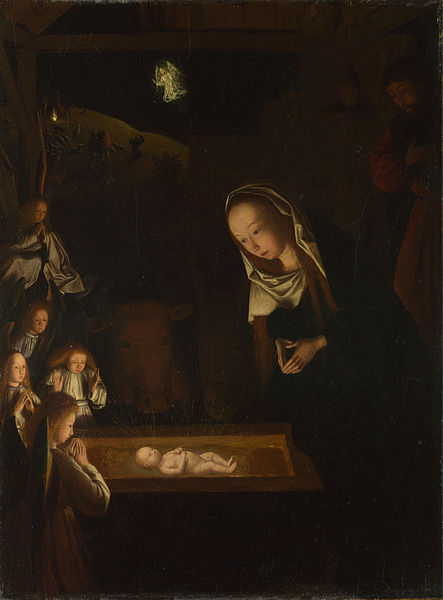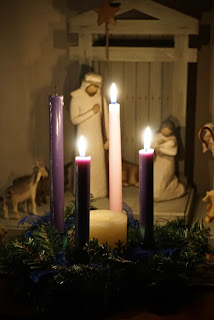Luke 2: 21-40
 |
| Photo by Annie Spratt on Unsplash |
A few minutes before the stroke of midnight on New Year’s Eve, one of the many celebrants gathered in a small bar walked over to a microphone on the tiny stage and announced,
"It’s almost midnight, so everyone find the person here who means the most to you and pull them close!"
The following day the bartender ended up spending his New Year’s Day in the hospital after being swarmed by the entire bar.
~
Today is New Year’s Eve!
It is not a liturgical holiday, and in many cases it will not be recognized in any way shape or form within most congregations.
Many congregations pick today to do a hymn sing.
It’s a great way to recuperate from countless hours of sermon writing and worship preparation through the month of December.
Some congregations will just jump ahead to Epiphany and celebrate the story and the feast in which we recognize how our Lord was revealed to ALL the nations through the magi.
I’m not knockin' it, but today is a real opportunity for the church to speak directly to all people about who we hold close as the New Year draws closer to us.
Even more importantly it is an opportunity for us as God’s people to consider just who holds us close as that clock ticks closer to midnight.
New Year’s may not be a liturgical holiday, but it is a festive time that evokes numerous forms of ritual and tradition.
In my household, I’ve always ensured that pork and sauerkraut were prepared for the first day of the year.
My wife grew up with ham and black eyed peas.
Others have traditions that include different types of noodles, fish, greens, and cakes.
For most of us, these traditions are rooted in some kind of meaning.
For instance, pork is a symbol of plenty, not only a hearty and fatty animal, but one that always moves forward when foraging for food, unlike chickens and turkeys.
 |
| Photo by Annie Spratt on Unsplash |
Black eyed peas are said to look like coins and therefore are a sign of wealth in the coming year.
And each of these foods carry some kind of symbolism that has been lost over time.
Traditions that we take part in because it's just something we’ve always done, yet the meaning has been lost.
~
In our Gospel today, something similar has transpired surrounding the rituals that Mary and Joseph have traveled to the temple to take part in.
The first is the circumcision of every Jewish boy, a ritual that takes place after the eighth day of the child’s birth.
It is a ritual that takes place at the hands of, not a medical professional, but a priest.
This is a practice that still happens today within the Jewish community.
The second ritual is the purification of the mother. For forty days after the birth she is not permitted to enter into the temple and is usually confined to her own household, until this ceremony is completed.
And the ritual which our Gospel focuses on closely is the redemption of the first born.
These are three rituals that aren’t really mentioned in Mark or Matthew’s accounts.
It's also pretty odd that we as Christians seem to focus much more on the naming and circumcision of Jesus than the ceremony that Luke selects as the backdrop for our Gospel today.
It’s a practice taken from the story of the Passover, the night in which all the first born of Egypt died, both children and animals, as a result of Pharaoh’s refusal to let the Hebrew slaves go.
It was only by following God’s instructions, through Moses, that the Hebrew people were spared this fate.
But, in being spared, all of the Hebrew first born are to be devoted to God.
Not only children, but cattle, crops, everything.
NOW, you can see why we like to skip this one.
Sounds a bit too Rumpelstiltskin for most of us, I’d say.
Doesn’t come across any better when you read it straight out of Exodus either.
All that first opens the womb is mine, all your male livestock, the firstborn of cow and sheep.The firstborn of a donkey you shall redeem with a lamb, or if you will not redeem it you shall break its neck. All the firstborn of your sons you shall redeem. No one shall appear before me empty-handed.
That does sound pretty Rumpelstiltskin doesn’t it?
But that isn’t the way they saw God, and I don’t think it is the way we should see God either.
To be dedicated, devoted, set aside, lifted up, offered to God, as God’s own, should be an honor. It was meant to be an honor.
But it becomes an honor that is bestowed upon the Israelite tribe of Levi, exclusively.
The tribe of Levi becomes solely dedicated to God, as the worship leaders of Israel, the ones who’ve been dedicated to the service of God.
A role and an honor that many Israelites envied and resented.
So, somehow the practice of giving the first born child to God, actually becomes the practice of God, giving the first born child back to the family for the price of two turtledoves.
Probably not how this ceremony was intended to take place, but the story Luke tells takes an old ceremony and shows how God breathes new life into it.
 |
| Rembrandt, Simeon's song of praise, 1631 (PD) |
After the hustle and bustle of the last month, I finally got a shot at going to see the new Star Wars movie The Last Jedi.
The title alone was intriguing to anyone who has ever followed the series, even a little bit.
Because the Jedi are not just your everyday average heroes that you can find in other films.
They are practitioners of a religious order, devoted to traditions and rituals, many of which are revealed in this newest film.
They are practitioners of a religious order, devoted to traditions and rituals, many of which are revealed in this newest film.
What I found the most intriguing about the story
-And don’t worry, I’m not going to give it all away!-
is that one of the central issues for Luke Skywalker in the film, is whether or not to continue practicing these rituals.
He spends much of the film considering whether or not to continue passing along the Jedi religion.
Because he recognizes that religious practice is not perfect.
Sometimes it is even flawed.
Sometimes it is even flawed.
What I truly valued about the film was that it made me revisit a very Lutheran concern.
What is it that our rituals and traditions are meant to point to?
God!
For Luke Skywalker, the question throughout the entire movie was whether the practice is more important than what is at the center of not only religion but every aspect of life, daily life.
The act of living, loving, breathing, dying, all of it!
Rituals, traditions, religion, they are invaluable IF they point to the source of all goodness.
~
This ritual that has just taken place seems a bit outdated, not only for us, but for Mary and Joseph.
After all, if the first born is meant to serve God in the temple and those duties are already being performed by others, do they really need to cook a couple pigeons to make up the difference?
But just like in the story of Jesus’ birth, God doesn’t always work the same way we expect.
And I found myself a bit shocked as I dug through our Gospel for today, because God very honestly slapped me in the face with this text when I realized how powerful it was!
God may come into the world in a stable, but it is in this story, that God gives God’s very own self to us.
How can Mary and Joseph give God to God?
They can’t!
So, the redeeming of Jesus is no fulfillment of any ransom with God. It is the act of God being handed over, completely to us, by God’s own hand!
God gives US all God has, all God is, fully and completely.
God takes this practice that may have lost its meaning altogether and flips it on its ear for us!
This only furthers God’s commitment to us!
God’s devotion to us, handed over fully into our hands, as a sacrifice that will be made to US!
A complete reversal that is heart wrenchingly powerful.
And it is in realizing this, that we can fully appreciate the beauty of Simeon and Anna’s recognition of just who Jesus is.
 |
| Anonymous, The Meeting of Our Lord (Russian Icon, 15th Century) (PD) |
They recognize in their passing that God has just been handed over to us all, not in a stable, not even by Pilate before the crucifixion, but in this ceremony that has been redirected toward God’s purpose for us all.
It is what moves Simeon to recognize this infant as the salvation his eyes have seen, the light that will be revealed to all people, a child that will be destined for the falling and rising of many, a sword that will pierce all of our souls.
Simeon and Anna, two devoted and faithful worshippers, who’ve devoted their lives not to rituals, traditions, or even religion, but to God.
Yes, they’ve been practitioners of the faith but in all the prayers they’ve raised, it is their hearts that have been seeking God, the one who they’ve devoted themselves to.
And through those traditions and practices, they finally see the God that has been devoted to not only them, but to the world.
THAT is not the power of rituals, traditions, or even religion, it is the power of God, working through rituals, traditions, and religion, IF we place ourselves before God and invite God to be at the center of what we do in those rituals, traditions, and religion.
~
So, today is New Year’s Eve.
There will good luck foods, good luck drinks, good luck kisses.
There’ll be balls droppin’ and confetti flyin’.
Some folks, who know the words, will even be singing Auld Lang Syne.
But in a few moments I am going to ask you all to consider preparing for this New Year, through a brief litany that John Wesley introduced to the Christian faith when he suggested that we consider every opportunity to give ourselves to God, and renew a covenant with God, to make God at the center of what we do.
In the same way that God came into the center of our world and lives, out of love for each and every one of us, through Jesus Christ.
So, as we go into 2018, celebrating with all kinds of rituals and resolutions, I ask you to join me in inviting God to be at the center of our lives in the year ahead, pulling God closer to us, into our daily living.
And I promise you, we’ll be far less crowded here than at your local gym, at least for the first two weeks.
Amen.
 |
| Alexei Yegrov, Simeon the Godreceiver 1830-1840's (PD) |
Sources
Dalferth, Ingolf U. Crucified and Resurrected: Restructuring the Grammar of Christology. Grand Rapids, Michigan: Baker Academic, 2015.
Johnson, Rian. Lucas, George. Star Wars: The Last Jedi. Walt Disney Studios Motion Pictures/Lucasfilm ltd., 2017
Lenski, R. C. H. Interpretation of St Luke’s Gospel. Minneapolis, Minn.: Augsburg Fortress, 2008.










